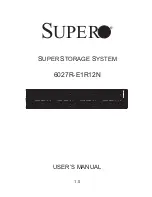Reviews:
No comments
Related manuals for AP1720-E1

X-25
Brand: Xblue Networks Pages: 148

6027R-E1R12N
Brand: Supero Pages: 112

8649 - Eserver xSeries 225
Brand: IBM Pages: 194

Fastora NAS T2
Brand: Fastora Pages: 24

SCH-401
Brand: 7starlake Pages: 67

Sun Fire X2100 M2
Brand: Sun Microsystems Pages: 128

Snap! Server 4000
Brand: Quantum Pages: 8

VESR4x4
Brand: B&B Electronics Pages: 2

S1600e
Brand: SmartSight Pages: 113

EKI-1526
Brand: Advantech Pages: 96

Devos 4
Brand: Discover Video Pages: 148

B2932
Brand: TYAN Pages: 81

FusionServer XH321 V5
Brand: xFusion Digital Technologies Pages: 76

PRIMERGY BX620 S5
Brand: Fujitsu Pages: 50

PRIMERGY BX620 S4
Brand: Fujitsu Pages: 81

PRIMERGY BX900 S1
Brand: Fujitsu Pages: 46

PRIMERGY BX620 S6
Brand: Fujitsu Pages: 56

Primergy BX920 S4
Brand: Fujitsu Pages: 66

















